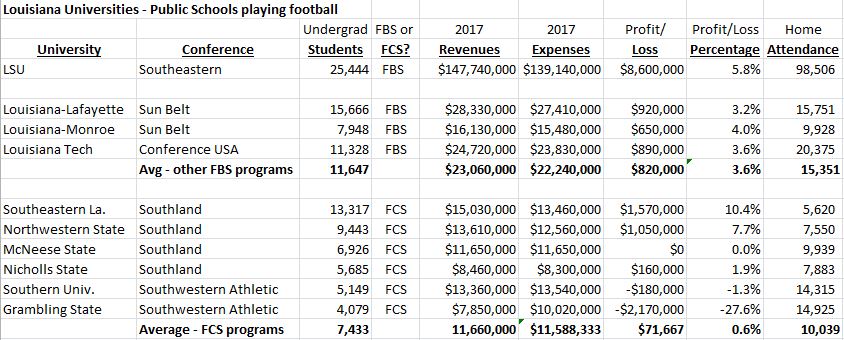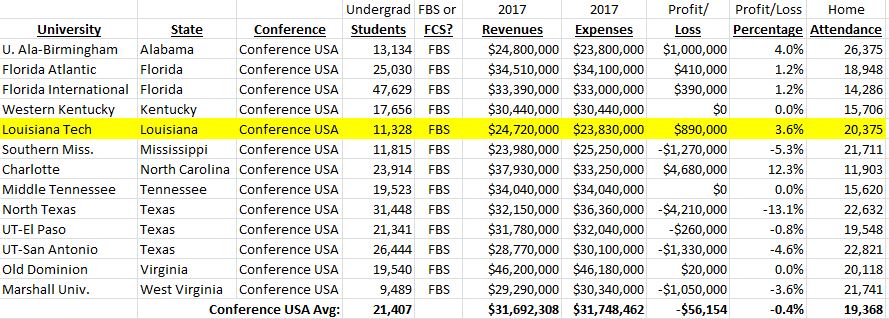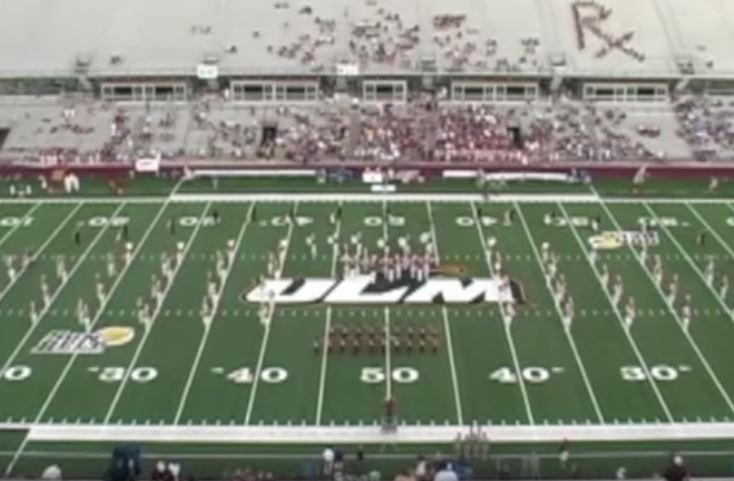Podcast: Play in new window | Download
Subscribe: RSS
With 130 large universities participating in the NCAA’s top athletics division (the BCS), the University of Louisiana at Monroe has the smallest athletics budget and annual revenue within the entire upper tier group.
To its credit, ULM fields competitive teams in most major sports and has done an amazing job when considering its fiscal disadvantage in comparison to most other universities.
In Louisiana, the King Kong of college athletics is certainly Louisiana State University. The LSU Tigers just won the BCS college football championship, and its college football program fuels and financially supports most of the other sports on campus.
How big is the fiscal disparity between the athletics budget of LSU and ULM?
According a recent report from the state of Louisiana’s Legislative Auditor, ULM reported total athletic revenues of $15,568,952 while its expenses amounted to $16,927,856, coming out to a deficit of $1,358,904 from July 1, 2018 to June 30, 2019.
In comparison, it was recently reported that the LSU athletics revenue totaled a whopping $157.8 million over the same period.
We don’t need a calculator to see that LSU generated ten times the annual revenue from its college athletics program than their friends on the Bayou in northeast Louisiana at UL-Monroe.
LSU is the state of Louisiana’s flagship university for several important programs and has over 25,000 undergraduate students. By comparison, ULM is home of the state’s nationally-recognized public Professional Pharmacy program. But the Fightin’ Pharmacists and ULM’s 8,000 undergrad students in Monroe won’t be able to compete at the same fiscal playing field with LSU’s athletics program anytime soon – if ever.
The state of Louisiana makes no bones about its love affair with football. The NFL’s New Orleans Saints are cherished and beloved within the state and the Gulf South region.
Louisiana’s high school football programs have long been known as fertile recruiting grounds for major college football programs around the country. The last two ACC “Offensive Player of the Year” awards have gone to running back Travis Etienne of Clemson. He is from Jennings, Louisiana (just 94 miles west of the LSU campus in Baton Rouge).
The Bayou State is the 25th most populous of the 50 states with over 4.6 million residents. For a state of its size, Louisiana boasts an abundance of college football teams within its large number of state universities, too.
The Knight Commission on Intercollegiate Athletics has compiled a very interesting and thorough compilation of statistics regarding the financial revenues and expenses for the majority of college athletics programs for America’s public universities.
Let’s take a closer look at how the Louisiana state schools’ college athletics programs fared for the most recently published year in 2017:

Excluding private school Tulane, there are four Louisiana public universities currently competing in the 130-team upper division of college athletics known as the BCS group. LSU, the University of Louisiana – Lafayette, Louisiana Tech University, and the University of Louisiana at Monroe are all participating in the upper tier group.
LSU has long been a member of the Southeastern Conference. Louisiana Tech plays in Conference USA while both UL-Lafayette and UL-Monroe participate in the Sun Belt Conference for athletics.
Let’s now take a look at how Louisiana’s public schools not named LSU fare within their respective BCS conferences:
First, let’s evaluate Louisiana Tech. The Bulldogs participate in Conference USA which features a very large area geographic footprint with teams in Alabama, Florida, Kentucky, Mississippi, North Carolina, Tennessee, Texas, Virginia, and West Virginia in addition to Louisiana.

Louisiana Tech’s annual athletics revenues of about $24 million and undergraduate enrollment (11,328) place the school in the bottom tier of Conference USA, but the football team’s 2017 home average attendance (20,375) placed the Bulldogs slightly above the conference average of 19,368. More importantly, Louisiana Tech turned a small annual financial profit ($890,000) in 2017 compared to the C-USA average which saw a loss of -$56,154 per school.
For now, it looks like Louisiana Tech’s program seems to be a comfortable fit within the Conference USA group and is certainly holding its own on the athletics field with other member schools.
Now let’s take a closer look at Louisiana’s two universities in the Sunbelt Conference. Like Conference USA, the Sunbelt has expanded in recent years to include member schools located in Alabama, Arkansas, Georgia, North Carolina, South Carolina, and Texas in addition to Louisiana. Travel expenses can be significant for these athletic programs.
First, let’s review the UL Ragin’ Cajuns of Louisiana.

UL-Lafayette’s athletic revenues are about $28 million annually and slightly below the league’s average of $31 million. The university’s undergraduate enrollment of 15,666 puts the Ragin’Cajuns near the league’s average of 16,283 per school with home football game attendance also in the middle of the pack at 15,721 per home game.
Financially, UL-Lafayette appears to be turning a nice profit on its athletics program ($920,000 in 2017) and above the Sunbelt Conference average of $734,000 per school.
Like Louisiana Tech, the Ragin’ Cajuns seem to be a comfortable fit as a member of the Sunbelt Conference at this time.
That brings us to UL-Monroe.
Formerly known as the Northeast Louisiana University (NLU) Indians, the school opted to play-up into the NCAA’s upper division of athletics back in 1994. It played as an independent for several years before joining the Sunbelt Conference in 2001. The university, which changed its name to the University of Louisiana at Monroe in 1999, later adopted the nickname “Warhawks” shortly after the NCAA threatened sanctions if the school continued to use the name “Indians”.
Since joining the FBS group of larger schools in 1994, the ULM football team has struggled finish the season above the .500 mark. In 2012, the Warhawks posted an 8-4 regular season record and earned the team a spot in the Independence Bowl (losing to Ohio University). In 26 seasons competing in the NCAA’s top tier, the Warhawks have posted just that one winning season and bowl game appearance during the period.
Let’s now analyze UL-Monroe’s place in the Sunbelt Conference:

As discussed at the beginning of this story, the ULM Warhawks are overachievers on the field of play compared to the size of its athletics budget and revenue.
Within the Sunbelt Conference, ULM ranks last in revenue, average home football attendance, and undergraduate students enrolled.
With a Sunbelt Conference average of $31 million in average athletics revenue, the Warhawks are about 50% of the conference average. The same goes for both average home football attendance and student size.
It is a testament to the school’s athletics department and student athletes that the ULM Warhawks generally field competitive teams in most of the Sunbelt Conference sports programs.
In our next post, we’ll discuss the options for UL-Monroe going forward. The university’s president is retiring soon, and this might be a good time to take a practical look at whether UL-Monroe wants to remain a small fry in the large-school BCS or return to the smaller school FCS and try to ascend to the top again with its athletics programs.

